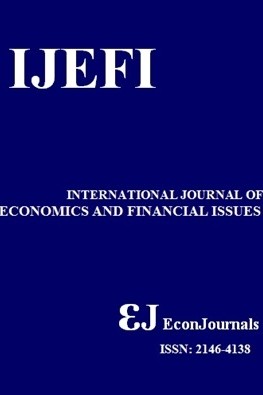Macroeconomic Variables and Unemployment: The Case of Turkey
Macroeconomic Variables and Unemployment: The Case of Turkey
___
- Aktar, I., Ozturk, L. (2009), Can Unemployment be Cured by Economic Growth and Foreign Direct Investment in Turkey. International Research Journal of Finance and Economics. 27, 203-211.
- Berument, M.H. (2008), Macroeconomic Policy and Unemployment by Economic Activity: Evidence from Turkey. IZA Discussion Paper: 3461.
- Berument, M.H., Dogan, N., Tansel, A. (2006), Economic Performance and Unemployment: Evidence from and Emerging Economy. International Journal of Manpower, 27(7), 604-623.
- Berument, M.H., N. Dogan, A. Tansel, (2009), Macroeconomic Policy and Unemployment by Economic Activity: Evidence from Turkey. Emerging Markets Finance and Trade, 45(3), 21-34.
- Butkiewicz, J.L., Ozdogan, Z. (2009), Financial Crisis, Monetary Policy Reform and The Monetary Transmission Mechanism in Turkey. Working Paper Series, no 2009-04, Department of Economics, Alfred Lerner College of Business & Economics, University of Delaware.
- Cascio, I.L. (2001), Do Labour Markets Really Matter? Monetary Shocks and Asymetric Effects across Europe. Unpublished, Department of Economics, University of Essex, Colchester.
- Daly, M., Hobijn, B. (2010), Okun’s Law and Unemployment Suprise of 2009. Economic Letter, Federal Reserve Bank of San Francisco.
- Doğrul, H.G., Soytas, U. (2010), Relationship between Oil Prices, Interest Rate, and Unemployment: Evidence from an Emerging Market. Energy Economics, 32, 1523-1528.
- Engle, R., Granger, C. (1987), Co-integration and Error correction: Representation,Estimation, and Testing. Econometrica, 55, 251–276.
- Johansen, S. (1991), Estimation and Hypothesis Testing of Cointegration Vectors in Gaussian Vector Autoregressive Models. Econometrica, 59, 1551–1580.
- Lee, J., Strazicich, M.C. (2003), Minimum LM Unit Root Test with Two Structural Breaks. Review of Economics and Statistics, 85 (4), 1082-1089.
- Lumsdaine, R.L., Papell, D.H. (1997), Multiple Trend Breaks and Unit-Root Hypothesis. The Review of Economics and Statistics, 79(2), 212-218.
- Pesaran, M.H., Shin, Y. (1998), Generalised Impulse Repsonse Analysis in Linear Multivariate Model. Economic Letters, 58, 17-29.
- Perron, P. (1989), The Great Crash, the Oil Price Shock, and the Unit Root Hypothesis. Econometrica, 57, 1361-1401.
- Ravn, M.O., Simonelli, S. (2007), Labor Market Dynamics and the Business Cycle: Structural Evidence for the United States. Working Paper Series, no 182, Centre for Studies in Economics and Finance.
- Said, S.E., Dickey, D.A. (1984), Testing for Unit Roots in Autoregressive-Moving Average Models of Unknown Order. Biometrika, 71(3), 599-607.
- Sims, C. A. (1982), Policy Analysis with Econometric Models. Brookings Papers on Economic Activity, 1, 107-152.
- Valletta, R., Kuang, K. (2010), Is the Structural Unemployment on the Rise? The Economic Report, 86(273), 185-209.
- Yeldan, E. (2002), Behind the 2000/2001 Turkish Crisis: Stability, Credibility, and Governance, for Whom? IDEAs Conference on International Money and Developing Countries: Theoretical and Policy Issue in the Current Context, 16-19 December, Chennai, India
- Zivot, E., Andrews, D.W.K. (1992), Further Evidence on the Great Crash, Oil-Price Shock and the Unit-Root Hypothesis. Journal of Business and Economic Statistics, 10(3), 251-270.
- Başlangıç: 2011
- Yayıncı: İlhan ÖZTÜRK
Modelling the Dependence Structure of MUR/USD and MUR/INR Exchange Rates using Copula
Vandna Jowaheer, Nafeessah Z. B. Ameerudden
Impact of NAFTA on the Preference for Meat Consumption in USA: An Inverse Demand System Approach
Central Banks’ Response to the Current Financial Crisis – Between Costs and Benefits
Teodora Cristina Barbu, Iustina Boitan
Domestic and Foreign Banks’ Profitability: Differences and Their Determinants
Macroeconomic Variables and Unemployment: The Case of Turkey
Capital Mobility: An application of Saving-Investment Link for Tunisia
Solarin Sakiru Adebola, Jauhari Dahalan
Contagion in International Stock Markets during the Sub Prime Mortgage Crisis
Debt Ratio Analysis and Firm Investment: Evidence from Jordan
